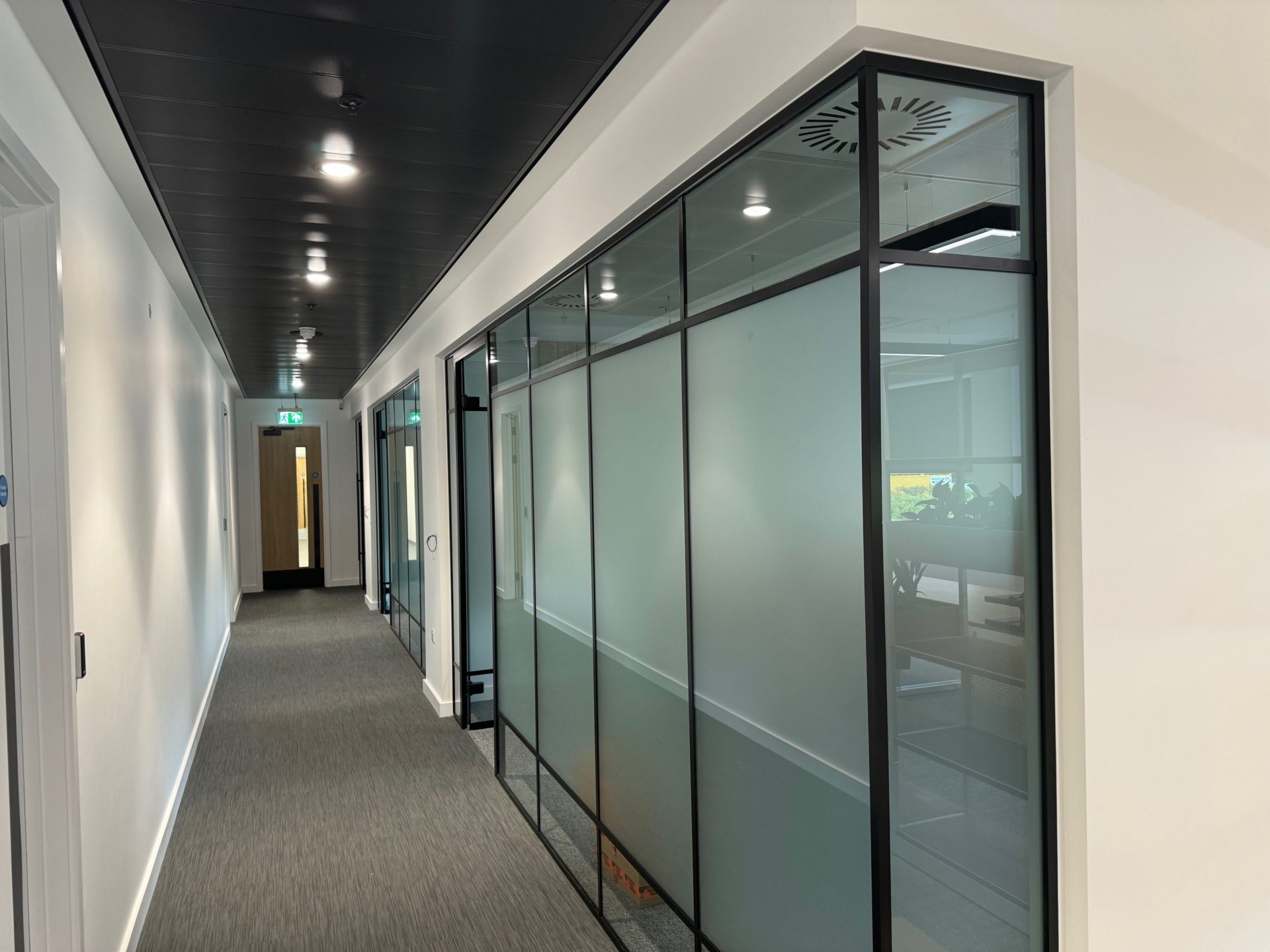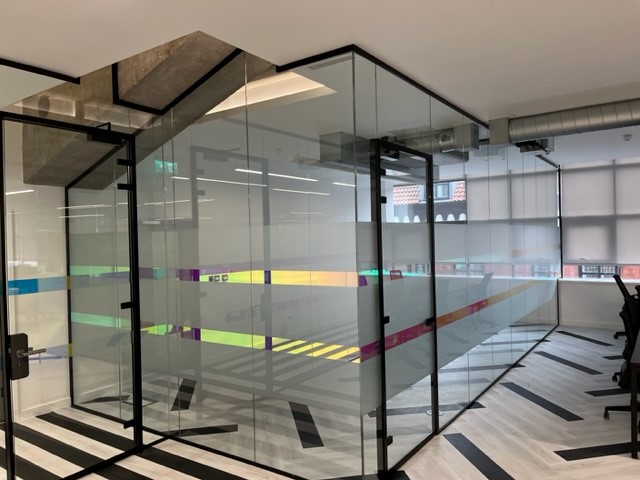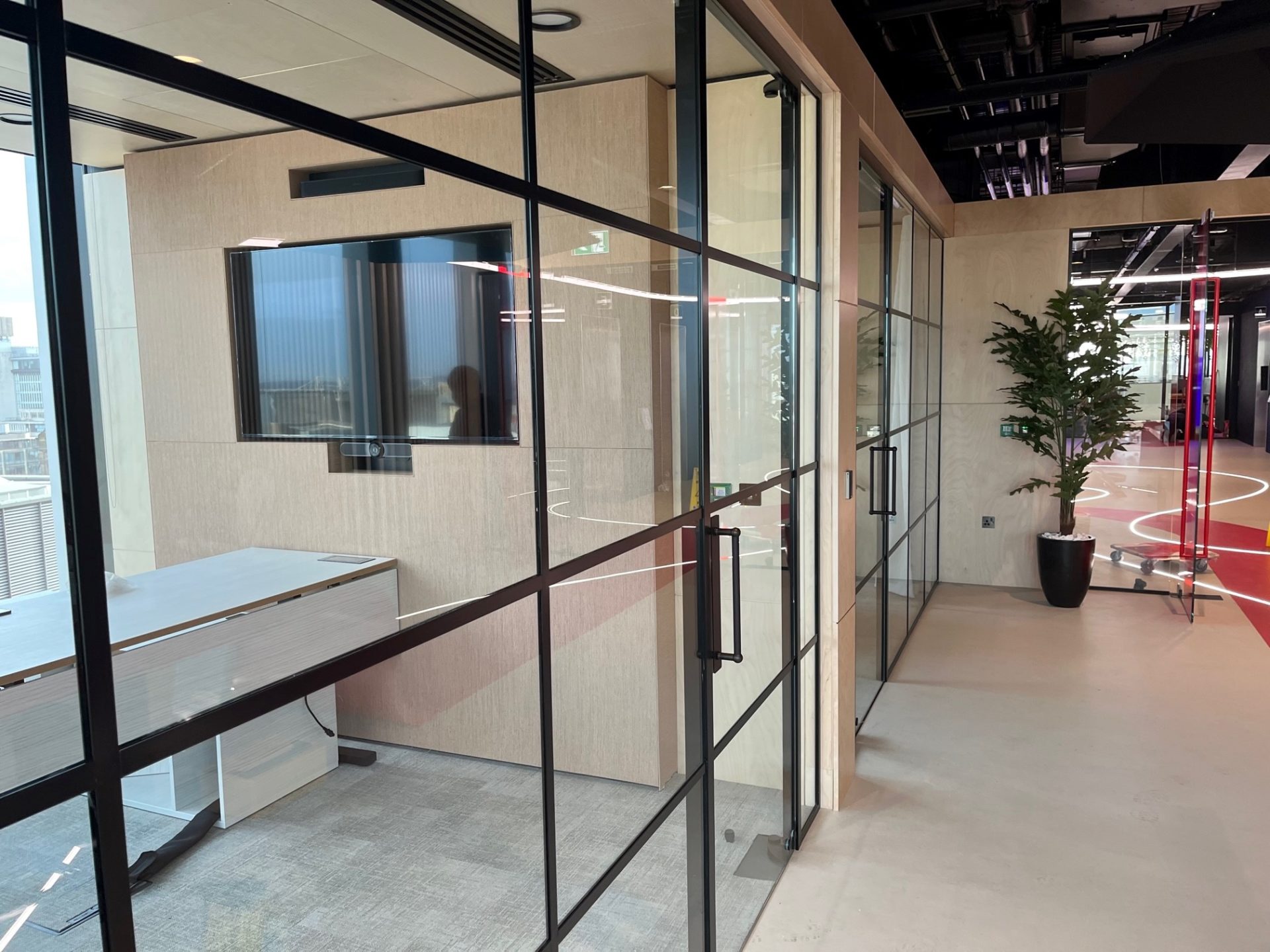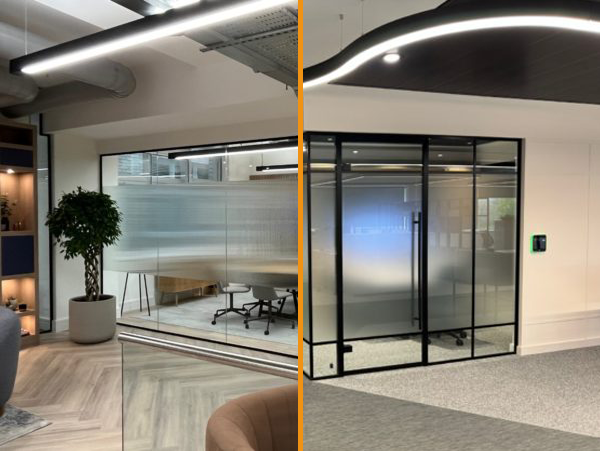04 / 06 / 2025
What’s The Difference Between Framed and Frameless Glass Partitions?
In this blog, we are discussing what separates framed from frameless glass partitions, the pros and cons of each, and how to decide which option is the most ideal for your workspace.
Glass partitions are one of the most popular solutions for enhancing space and modernising offices up and down the UK. With many benefits, including an influx of natural light, versatility, open space, and improved aesthetics, it’s no wonder they have become the go-to option for many workspaces.
Choosing to include glass partitions in your office isn’t a one-size-fits-all decision, however. There are various factors to consider, one of which is choosing between framed glass partitions and frameless glass partitions. But what is the difference?

What are glass partitions?
Firstly, we’ll touch on what exactly glass partitions are. To put it simply, glass partitions are non-load-bearing glass walls used to divide space within a room or building, such as an office. Their main purpose is to create smaller workspaces or private meeting rooms, adding versatility and function to an office.
What are framed glass partitions?
Framed glass partitions are the most common and standard partitions you are likely to see. The name gives it away, but a framed glass partition is a glass panel, surrounded by a frame. Frames are typically made from materials such as aluminium, steel, or wood, and add structure and support for the glass partition.
Key features of framed glass partitions
Structural Support: The frame adds structure and support to the glass partitions, therefore helping to protect the glass and reduce the risk of chipping or cracking.
Material Variety: As we’ve mentioned, frames can be made from a variety of different materials, including aluminium, steel, or wood, all providing a different aesthetic.
Easy Installation: As framed glass partitions are the standard design, their installation is straightforward and the easier of the two options.
Advantages of framed glass partitions
Cost-Effectiveness: One of the big differences between framed and frameless glass partitions is the cost difference. Framed glass partitions are generally more affordable than their frameless counterparts. This is due to the specialist installation process required for frameless glass partitions.
Sound Insulation: Framed glass partitions often provide a greater level of soundproofing, due to the seals around the frames, helping to block out sound. This makes them an ideal choice when aiming to create private meeting rooms or independent work areas.
Durability: Due to their increased structural support, framed glass partitions tend to be more durable, meaning there is a reduced risk of glass chipping or breakage.
Disadvantages of framed glass partitions
Maintenance: A small setback you’ll often face with framed glass partitions is the maintenance they require. With frames comes dust. Dust can easily and quickly build up in the nooks and crannies of framed partitions, meaning they require regular cleaning to maintain their appearance.
Less Aesthetic Appeal: This disadvantage is subjective to personal preference, but framed glass partitions can be seen as less attractive to the eye due to their bulkier frame. They can look less minimalist and modern compared to frameless glass partitions, but that’s all up to you.

What are frameless glass partitions?
Now we will discuss frameless glass partitions. Opposite to framed partitions, frameless partitions simply don’t include a frame. They rely on discreet fixings to provide them with structure and support, giving them an ‘invisible’ look. The result of this is a cleaner and sleeker appearance.
Key features of frameless glass partitions
Minimalist Aesthetic: A key feature of frameless partitions is the lack of a visible frame. With no frame comes a more seamless, open feel that helps add to the illusion of space in an otherwise small or cramped office.
Durability: Due to no frame, the glass used for frameless glass partitions must be thicker and tougher to maintain the structural integrity.
Flexibility: Frameless glass partitions often have the ability to slide or pivot, adding an extra layer of flexibility and functionality that framed partitions fail to provide.
Discreet: With no frame, frameless partitions instead use discreet fixings or channels that help to maintain their clean appearance.
For a more in-depth breakdown of why you should choose frameless glass partitions, read our blog, ‘Give your office the ‘wow’ factor with Frameless Glazing’.
Advantages of frameless partitions
Natural Light: Both framed and frameless glass partitions aid in allowing a greater influx of natural light; however, frameless glass partitions do it better. The lack of a frame helps to maximise the natural light in an office, creating a brighter workspace.
Modern Look: Frameless glass partitions are often favoured in offices that want to maximise modernity, thanks to their sleek and clean aesthetic.
Customisation: As mentioned above, frameless partitions have greater flexibility in that they can slide and pivot. However, they can also be customised with added detail such as frosting, etching, or tinting.
Disadvantages of frameless partitions
Increased Cost: Due to their more complex installation process and need for higher-quality glass, frameless partitions are generally more expensive than framed partitions.
Complex Installation: As above, frameless partitions require a lengthier and more complex installation to ensure stability and safety. To find out more, read our blog on ‘Installing a Frameless Glazed Door: A How to Guide’.
Lower Soundproofing: An advantage of framed partitions is their improved acoustics, so a downside of frameless glass partitions is their reduced soundproofing due to less fixings and seals.

Choosing between framed and frameless glass partitions
Now that we have discussed all the key features, advantages, and disadvantages of framed vs frameless glass partitions, it is time to decide which option is best for you. This decision weighs on several factors, such as budget, functionality, and aesthetics.
When to choose framed glass partitions
- Framed glass partitions may be the best option for you when budget is a top priority, as framed partitions are a more cost-effective solution.
- If your office space tends to get quite busy, with lots of hustle and bustle throughout the day, the added durability of framed partitions may be the best option for high-traffic areas.
- Finally, if soundproofing is important for your office space, particularly if you plan on dividing your space into private meeting rooms, framed partitions may be the better choice due to their improved acoustics.
When to choose frameless glass partitions
- If the main attraction of glass partitions is to improve the aesthetics of your office, you may decide that frameless partitions are your ideal choice. Frameless glass partitions provide any space with a sleek and contemporary look.
- To really maximise the influx of natural light in your office, frameless partitions are the way to go.

Whether you decide to install framed or frameless glass partitions into your workspace, both options provide unique characteristics that are sure to elevate your office. With many factors to consider, this blog should have provided you with a clear breakdown of the pros and cons of each.
If you are considering glass partitions for your office, you should ensure you choose the right business to partner with. Office Blinds and Glazing is your ideal choice, with over 30 years of experience and one of the UK’s leading independent specialist suppliers and installers of Glass Partitions and Glass Fire Screens.
Get in touch with our team of experts today to begin your journey to a better working environment.
Enjoy this article? You might be interested in some of our others:
01 / 07 / 2025
Top Tips On Improving Your Workspace Or Office
In this blog, we are discussing some top tips on improving your workspace or office, and the impact they can have on productivity and aesthetics.


